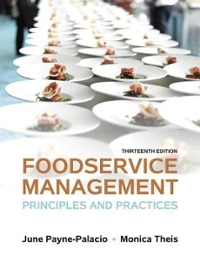Question
QUESTIONS: Provide an insight you gained from the passages your colleague found compelling or from another example from the book. Ask a clarifying question about
QUESTIONS:
- Provide an insight you gained from the passages your colleague found compelling or from another example from the book.
- Ask a clarifying question about your colleague's analysis, either of the concepts from the book or of their reflection on past experiences.
The constraints evident to UniCo's efficiency are related to its surplus of inventory which can be drawn from issues in company policy and utilization of resources (Dalton, 2009; Goldratt & Cox, 2014). Dalton (2009) states that organizations must exercise the five steps in the Theory of Constraintsidentify, exploit, subordinate, elevate, and start againto drive performance and eliminate existing issues (p. 55). Alex Rogo's search for a solution to UniCo's account has led him to question managements fixation on operating expenses and apply a new perspective (Goldratt & Cox, 2014).
The first passage that I found vital to UniCo's problem is found in chapter 19. Jonah tours the plant and identifies the need to make money (UniCo's goal) (Goldratt & Cox, 2014). He also identifies the bottlenecks within the production department. Finally, he explains how to increase daily throughput (e.g., shift parts to non-bottlenecks, use another machine to do the same process, outsource to an available vendor) (Goldratt & Cox, 2014). By increasing throughput in this capacity, UniCo can effectively manage its time, decrease building an idle inventory, and sustain cash flow.
Another key to improving constraints is when Alex Rogo and Bob Donovan run into an issue of policy and break the ruleschapter 21. For example, Otto maintained standard operating procedures and ran other batched parts, but they explained that they did not need to produce any non-bottleneck parts; Otto must continue processing orders by that of importance (Goldratt & Cox, 2014). Within a few days, Alex and Bob gathered the plant in shifts to explain a new systemusing red and green tagsto help the plant process priority parts and eliminate miscommunication and bottlenecking (Goldratt & Cox, 2014). The new policy decreases bad multitasking (e.g., the example of Otto), implements a buffer (e.g., highest priority takes precedence), and avoids early starts (e.g., do not jumpstart low priority batches) (Goldratt & Cox, 2014).
Lastly, in chapter 23, we learn that the heat-treat constraint is highly inefficient as one order was left in the furnace for two and a half hours (Goldratt & Cox, 2014). Alex moves to assign dedicated staff, and a foreman suggests a change process to improve efficiency (e.g., Mike Haley splitting and overlapping batches) (Goldratt & Cox, 2014). Moreover, Bob notifies Alex to authorize slower processing within the machinery centers to save twenty percent on heat treating with the furnaces (Goldratt & Cox, 2014). By helping ease the workload on the constraints and borrowing from non-constraints, Alex and his staff can increase their throughput, reduce their inventory and investment, and potentially reduce overall operating expenditures (Dalton, 2009). In summary, Alex and his team worked to identify and map out their constraints, establish clear objectives and redefine their policies and procedures and focused on decreasing resistance to change (Dalton, 2009). As future managers, we must take one step at a time, involve and train people, examine resistance, and be receptive to new opinions to improve performance and eliminate constraints (Dalton, 2009).
References
Dalton, M. A. (2009). What's constraining your innovation?Research Technology Management, 52(5), 52-64.
Goldratt, E. & Cox, J. (2014). The Goal: A Process of Ongoing Improvement. (4th ed.). Great Barrington, MA: North River Press.
Step by Step Solution
There are 3 Steps involved in it
Step: 1

Get Instant Access to Expert-Tailored Solutions
See step-by-step solutions with expert insights and AI powered tools for academic success
Step: 2

Step: 3

Ace Your Homework with AI
Get the answers you need in no time with our AI-driven, step-by-step assistance
Get Started


